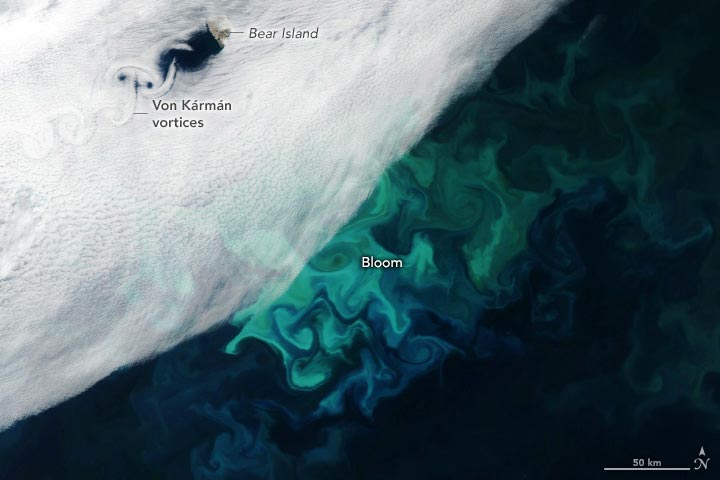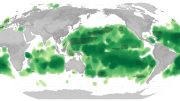
Satellite image of Norway’s Bear Island acquired on July 13, 2023, by Moderate Resolution Imaging Spectroradiometer on NASA’s Aqua satellite shows Von Kármán vortices in the clouds and swirling tendrils of a phytoplankton bloom in the Norwegian and Barents Sea.
Fluid dynamics put on a spectacular show around Norway’s remote Bear Island.
Theodore von Kármán, a Hungarian-American physicist, is well-known within NASA for helping found the Jet Propulsion Laboratory. But in atmospheric science circles, he is most celebrated for his research on fluid turbulence and his pioneering work on a phenomenon that came to be known as von Kármán vortices.
Formation of von Kármán Vortices
Von Kármán vortices appear as long linear chains of spiral eddies and can develop nearly anywhere that fluid flow is disturbed by an object. The atmosphere behaves like a fluid, so the wing of an airplane, a bridge, and even an island can cause the vortices to form.
A Spectacular Display at Bear Island
In this image, remote Bear Island (also called Bjórnóya)—the southernmost island of Norway’s Svalbard archipelago—helped trigger the spiraling cloud pattern. At the same time, another visually stunning phenomenon peeked through a break in the clouds: the tendrils of a phytoplankton bloom circulating in the surface currents of the Norwegian and Barents Sea. The MODIS (Moderate Resolution Imaging Spectroradiometer) on NASA’s Aqua satellite acquired the image on July 13, 2023.
Wildlife of Bear Island
Despite the name, polar bears only occasionally visit Bear Island. A handful of staffers at a meteorological station are the only people who spend much time on the island.
Foxes, seals, and sea birds are more common and numerous than either people or bears on the small island. According to the Ramsar Sites Information Service, more than one million seabirds gather there during the breeding season. Among them are the black-legged kittiwake (Rissa tridactyla), pink-footed geese (Anser branchyrhynchus), and the barnacle goose (Branta leucopsis).
NASA Earth Observatory image by Wanmei Liang, using MODIS data from NASA EOSDIS LANCE and GIBS/Worldview.









Be the first to comment on "Twists of Nature: Spectacular Swirls in the Sky and Sea Around Norway’s Remote Bear Island"